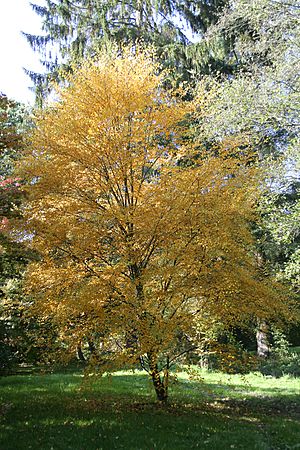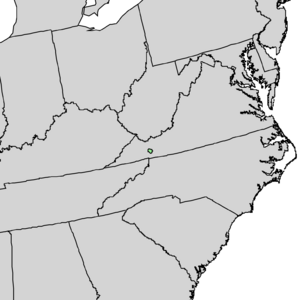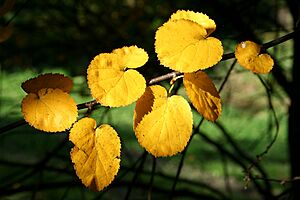Virginia round-leaf birch facts for kids
Quick facts for kids Virginia round-leaf birch |
|
|---|---|
 |
|
| Conservation status | |
| Scientific classification | |
| Kingdom: | |
| (unranked): | |
| (unranked): | |
| (unranked): | |
| Order: | |
| Family: | |
| Genus: | |
| Species: |
B. uber
|
| Binomial name | |
| Betula uber (Ashe) Fern.
|
|
 |
|
| Natural range of Betula uber | |
The Virginia round-leaf birch (scientific name: Betula uber) is a very rare type of tree. It belongs to the birch family, just like other birch trees you might know. This special tree is one of the most endangered species in North America.
You can only find it naturally in Smyth County, which is in the U.S. state of Virginia. It grows in temperate broadleaf and mixed forests, which are forests with many different kinds of trees.
Contents
About the Virginia Round-Leaf Birch
How it was Named
This tree was first described in 1914. Back then, scientists thought it was just a type of another birch tree, Betula lenta. But in 1945, they decided it was special enough to be its own species.
Sometimes, the Virginia round-leaf birch can mix with B. lenta. Some scientists even think it might be a special round-leaf version of B. lenta.
What it Looks Like
The Virginia round-leaf birch is a medium-sized tree. It can grow up to 15 meters (about 50 feet) tall. Its top part, called the crown, is usually neat and compact.
The bark of the tree smells nice and is dark brown or black. Its leaves are round or slightly oval. They have a heart-shaped base and jagged edges, growing up to 5 centimeters (about 2 inches) long.
Reproduction and Life Cycle
The tree has small structures called catkins, which are up to 2.8 centimeters (about 1 inch) long. These catkins hold tiny seeds called samaras, which are only 2 millimeters long.
The wind helps to spread the pollen from one tree to another. This tree reproduces by making seeds. Some years, the tree produces many more seeds than others. The Virginia round-leaf birch usually lives for about 50 years.
Protecting this Rare Tree
A Tree Thought to be Lost
After it was first found in 1914, the Virginia round-leaf birch disappeared. People thought it was extinct (meaning it had died out completely). But then, in 1975, some trees were found again!
Scientists found 18 adult trees and 23 younger trees (called saplings and seedlings). They were growing along a creek in Smyth County, Virginia.
Saving the Species
Because it was so rare, the U.S. government listed it as an endangered species. This meant special efforts began to protect it. Many young trees were grown in greenhouses and then planted in the forest.
By 1995, there were 20 different groups of these trees. Because of this success, its status was changed from "endangered" to "threatened." This means it's still at risk but doing a bit better.
Current Status
To help protect the trees, scientists grew them in nurseries. This helped stop people from taking wild trees or damaging them. In 2006, about 961 individual trees were counted in the wild. Only eight of these were in the very first group found by the creek.
The tree is still on the endangered species list. This is because scientists haven't seen it reproduce naturally very often. The area where the tree grows is surrounded by farmland, which limits how much it can spread. However, the land where the trees are now is not in immediate danger.



